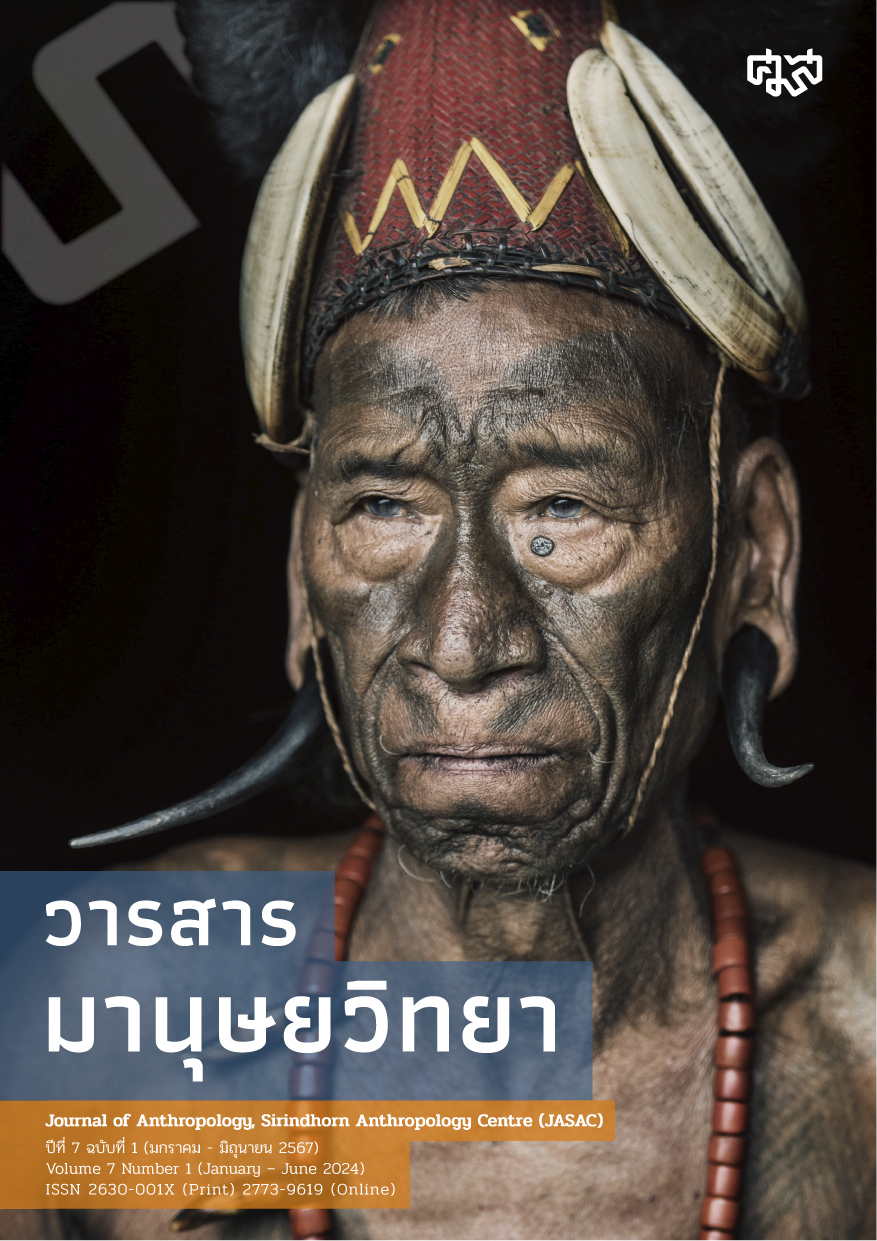ภูมิปัญญาเชิงนิเวศของนากาใน Son of the Thundercloud ของอีสเทอรีน คิรี
Main Article Content
บทคัดย่อ
เป้าหมายของบทความนี้คือ การทำความเข้าใจภูมิปัญญาเชิงนิเวศของชาวนากา โดยศึกษาผ่านวรรณกรรมของอีสเทอรีน คิริ เรื่อง Son of the Thundercloud ในวรรณกรรมเรื่องนี้ คิรีได้บันทึกเหตุการณ์สำคัญทางประวัติศาสตร์ของชาวนากา นั่นคือ ความแตกแยกในหมู่ชนนากาภายหลังจากการประกาศเอกราชของอินเดียและการผนวกเอาภูเขานากาเป็นส่วนหนึ่งของอินเดีย ซึ่งความขัดแย้งดังกล่าวคือมรดกของลัทธิอาณานิคมที่มาพร้อมกับวิธีคิดแบบชาตินิยม วรรณกรรมของคิรีซึ่งเป็นการนำนิทานปรัมปราที่แตกต่างหลากหลายของชาวนากามาเล่าใหม่ได้นำเสนอภูมิปัญญาเชิงนิเวศของชาวนากา ขณะที่สภาวะอาณานิคมและความคิดแบบชาตินิยมพยายามสถาปนาขอบเขตแบบรัฐประชาชาติหรือขอบเขตที่ตายตัวขึ้นมา แต่เรื่องเล่าของชาวนากาหรือโลกของชาวนากาที่ปรากฏผ่านงานของคิรีกลับเป็นการท้าทายข้อจำกัดของ “รัฐประชาชาติ” ที่วางอยู่บนการแยกและการกีดกัน พร้อมกันนี้ โลกของชาวนากาได้เสนอภววิทยาทางเลือกที่ต่างออกไป นั่นคือ โลกของชาวนากาเป็นการถักทอกันของบุคคลต่าง ๆ ทั้งมนุษย์และสิ่งที่ไม่ใช่มนุษย์ซึ่งอาศัยอยู่ร่วมโลกเดียวกัน การเล่าเรื่องจึงเป็นกระบวนการของการสร้างชุมชนที่หมายถึงการสร้าง “โลก” ซึ่งโลกดังกล่าวมีลักษณะเป็นพื้นที่เปิด ไม่มีขอบเขตที่แน่นอนตายตัวและสามารถตัดข้ามพรมแดน รวมไปถึงตัดข้ามความเป็นเรื่องเล่ากับเรื่องจริงด้วย ดังนั้น เรื่องเล่าเหล่านี้จึงไม่ใช่การสถาปนาเส้นเขตแดนตายตัวแบบรัฐประชาชาติ ด้วยเหตุนี้ ในโลกของชาวนากาจึงไม่สามารถลดทอนสรรพสิ่งไปเป็นปัจเจกบุคคลได้ เพราะกำเนิดของสรรพสิ่งทั้งที่เป็นมนุษย์และไม่ใช่มนุษย์ล้วนเกาะเกี่ยวสัมพันธ์กัน ซึ่งตรงกันข้ามกับวิธีคิดแบบทวินิยมที่มากับพร้อมกับสภาวะอาณานิคมตะวันตกที่แยกสรรพสิ่งออกจากกัน
Article Details

อนุญาตภายใต้เงื่อนไข Creative Commons Attribution-NonCommercial-NoDerivatives 4.0 International License.
ลิขสิทธิ์@ของวารสารมานุษยวิทยา
ศูนย์มานุษยวิทยาสิรินธร (องค์การมหาชน), กรุงเทพฯ, ประเทศไทย
ข้อมูลเพิ่มเติม:
https://creativecommons.org/licenses/by-nc-nd/4.0/
เอกสารอ้างอิง
เก่งกิจ กิติเรียงลาภ, พนา กันธา และพีรณัฐ พฤกษารัตน์. (2566). รื้อถอนสภาวะอาณานิคมและการสร้างโลกผ่านการเล่าซ้ำปรัมปราในวรรณกรรมของ Easterine Kire. รัฐศาสตร์สาร, 44(3), 67-110.
Abram, David. (2017). The Spell of the Sensuous: Perception and Language in a More-Than-Human World. New York: Vintage Books.
Baruah, Sanjib. (2020). In the Name of the Nation: India and Its Northeast. Stanford and California: Stanford University Press.
Descola, Phillipe. (2013). Beyond Nature and Culture, translated by Janet Lloyd. Chicago: University of Chicago Press.
Dutta Chowdury, Payel. (2015). Literary Representation of Women in the Angami Society: A Study of the Easterine Kire’s A Terrible Matriarchy. Pune Research Journal, 1(3), 1-6.
ICORN. (2006). AUTUMN 06 Featured Writer: Easterine Kire Iralu. Retrieved from https://www.icorn.org/article/autumn-06-featured-writer-easterine-kire-iralu?fbclid=IwAR2H9OIU7HsmeZeiruHZ9Qat2XXl2qeMzmQCM3hjPaaICEnDFARl8eYPNIA
Jamir, Chongpongmeren. (2020). Christianity in Northeast India: A Cultural History of Nagaland from 1947. London and New York: Routledge
Kire, Easterine. (2016). Son of the Thundercloud. New Delhi: Speaking Tiger.
Kire, Easterine. (2014). When the River Sleeps. New Delhi: Zubaan.
Kire, Easterine. (2011). Bitter Wormwood. New Delhi: Zubaan.
Kire, Easterine. (2009). Naga Folktales Retold. Tromsø: Barkweaver.
Kire, Easterine. (2007). A Terrible Matriarchy. New Delhi: Zubaan.
Ksh., Rajesh Singh. (2015). Coming of Christianity in the Naga Area of North East India IOSR Journal of Humanities and Social Science, 20(4), 13-17. Retrieved from https://www.iosrjournals.org/iosr-jhss/papers/Vol20-issue4/Version-4/C020441317.pdf
Michael Oppitz, Thomas Kaiser, Alban von Stockhausen, and Marion Wettstein (eds.). (2008). Naga Identities: Changing Local Cultures in the Northeast of India. Gent: Snoeck.
Ong, Walter J. (2002). Orality and Literacy: The Technologizing of the Word. London and New York: Routledge.
Ovesen, Jan. (1983). Man or beast? Lycanthropy in the Naga Hills. Ethnos: Journal of Anthropology, 48(1-2), 5-25. Retrieved from https://doi.org/10.1080/00141844.1983.9981251
Sahlins, Marshall. (2022). The New Science of the Enchanted Universe: An Anthropology of Most of Humanity. Princeton and Oxford: Princeton University Press.
Strathern, Alan. (2019). Unearthly Powers: Religious and Political Change in World History. Cambridge and New York: Cambridge University Press.
Teodorescu, Ana. (2022). Tiger Symbolism in the British Raj: Colonialism and Animal History of the Indian Subcontinent. Columbia Journal of Asia, 1(2), 66-77.
Tialila. (2022). Reading Magical Realism in Easterine Kire’s Novel When the River Sleeps. Quest Journals: Journal of Research in Humanities and Social Science, 10(8),199-203. Retrieved from https://www.questjournals.org/jrhss/papers/vol10-issue8/1008199203.pdf
Thomas, John. (2002). Evangelising the Nation: Religion and the Formation of Naga Political Identity. New Delhi, London and New York: Routledge.
Thong, Tezenlo. (2012). ‘To Raise the Savage to a Higher Level’: The Westernization of Nagas and their Culture. Modern Asian Studies, 46(4), 893-918. Retrieved from https://www.jstor.org/stable/41478422
Varah, Franky. (2013). Situating the Humans Relationship with Nature in the Tangkhul Naga’s Lifeworld. Journal of Human Ecology, 41(3), 247-254. Retrieved from https://doi.org/10.1080/09709274.2013.11906572
Viveiros de Castro, Eduardo. (2011). The Inconstancy of the Indian Soul: The Encounter of Catholics and Cannibals in 16th Century Brazil, translated by Gregory Duff Morton. Chicago: Prickly Paradigm.


